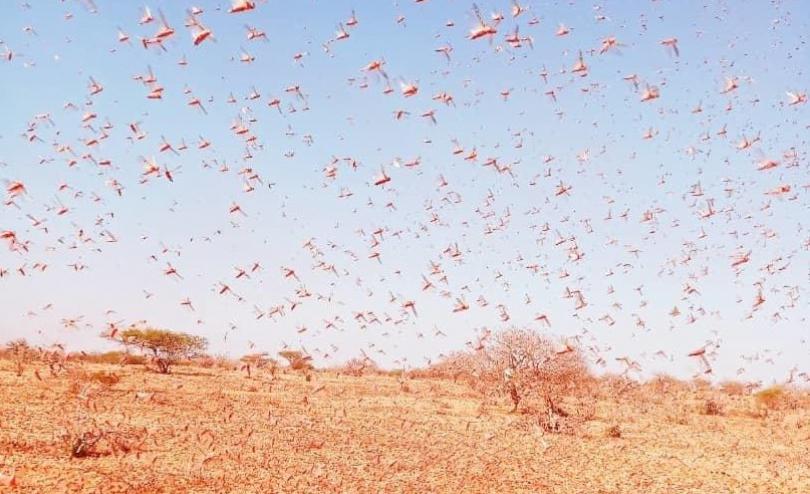Plague of locusts ravages three East African countries as region prepares for another year of hunger

Desert locusts are destroying crops across the Horn of Africa. Please find more photos and video here
The worst plague of Desert Locusts in a generation is ravaging crops and other vegetation across the Horn of Africa with Kenya, Ethiopia and Somalia battling to contain the escalating crisis. The outbreaks in Ethiopia and Somalia are the worst in 25 years and in Kenya the worst in 75 years.
Save the Children is gravely concerned for the estimated 3.7 million children across the three countries who are already experiencing crisis levels of hunger and are at risk of further deprivation as crops are decimated by the insects.*
Swarms as large as 2,400km– or more than three times the size of New York City - have been seen in northeast Kenya, with the locusts moving southward towards South Sudan and eastward towards Uganda. A swarm of this size, which can contain up to 192 billion locusts, is estimated to eat in one day the same as 90 million people.
The UN predicts that towards the end of January and February, families living in rural areas of the three countries could become in even more dire need of food as the infestation moves through pastureland and threatens staple food crops such as teff and maize, as well as grasses which provide crucial nutrition for livestock. Food shortages are already at critical levels across the three countries, with at least 1.38 million children suffering serious malnutrition and requiring treatment. **
The recent extended rainy season, which led to floods across the three countries, has provided favourable conditions for the breeding of locusts, which need moist, sandy soil to lay their eggs. Floods and heavy rains from Cyclone Pawan, which hit Somalia in December 2019, also helped create conditions for breeding.
Climate shocks remain a driving factor for acute food insecurity in the Horn of Africa and continue to severely affect several countries in the region. Rainfall between March and mid-May 2019 was less than 50 per cent of the annual average across the region and subsequent, heavy rainfall and flooding impacted nearly 2.8 million people across Ethiopia, Kenya and Somalia affecting and destroyed large swathes of crops.
Save the Children’s Regional Director for East and Southern Africa, Ian Vale, said:
This new disaster bodes ill for the region in 2020. We’re hearing shocking stories of the devastation these locust plagues are wrecking across the Horn. At least 70,000 hectares of land in Somaliland, Puntland and Galmudug is infested by locusts and our staff in Kenya are battling swarms so thick they can barely see through them.
The impact on crops and pastureland will be severe. We are very concerned that this will place vulnerable children even closer to the brink of starvation. Families are already struggling to find enough food to eat. The erratic weather of 2019 and the decade prior has already severely eroded the capacity of families to bounce back from unexpected crises. Pastoralists and farmers are some of those impacted the worst by these types of shocks, with their income and food security threatened.
Save the Children is calling on donors to increase and sustain funding for humanitarian assistance across the Horn of Africa to combat the ongoing hunger crisis. Save the Children is also appealing for support to help affected communities in the Horn of Africa adapt to their changing world, including funding to support the economic opportunities of communities who are vulnerable to climate-related disasters and programs that would support youth to find new means of generating income.
Save the Children is responding to the climate crisis in the Horn of Africa through meeting the immediate needs of those affected by droughts, floods and chronic food insecurity. In Somalia, the organisation is working towards ensuring affected children and their families have access to water, are supported through cash transfers and assistance with their livestock and have access to health and nutrition services.
In Ethiopia, Save the Children is covering 50 districts with health, nutrition, water and sanitation assistance, as well as cash transfers. In Kenya, it is providing nutrition, water and sanitation support particularly to assist malnourished children, as well as cash transfers to improve household food security.
For more information and to arrange interviews, please contact:
- Daphnee Cook in Nairobi: +254 717 524 904 [Mobile and Whatsapp] or daphnee.cook@savethechildren.org
- Jamillah Mwanjisi: jamillah.mwanjisi@savethechildren.org [M]+254 720 043823
- During out of office hours: media@savethechildren.org.uk / +44 7831 650409
NOTES TO EDITORS
* Estimated from under 18 populations in Ethiopia (48%), Somalia (54%) and Kenya (47%) as a proportion of the number of people in those countries experiencing IPC levels 3 and above: population data from UNICEF population statistics – under 18 demographics and the World Bank.
** In Kenya, more than 600,000 children require treatment for malnutrition [Government of Kenya [August 2019] Long Rains Season Assessment Report]. In Somalia, more than 600,000 children already require treatment for malnutrition. In Ethiopia, more than 600,000 require treatment for malnutrition.




